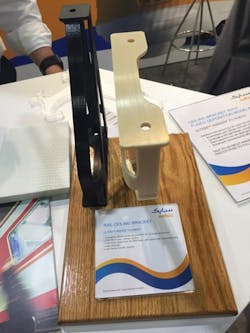At APTA Expo SABIC showcased its capabilities in additive manufacturing, glazing and carriage interiors that are aimed to assist rail engineers, designers and suppliers work to reduce both weight and maintenance. Among the featured products, SABIC had a bracket created using ULTEM AM9085F filament, designed for use with Stratasys Fortus printers.
"For rapid prototyping or replacement they use 3D printers to create it rapidly. These brackets save 50 percent of the weight," explained Stephan Plomp, sr. global business manager marketing, mass transportation - rail specilaties, SABIC.
The bracket, which is regularly made from sheet metal, is used in rail carriage hidden spaces to mount ceiling components. ULTEM AM9085F filament is made from SABIC’s ULTEM resin, offering the same composition as the company’s injection molding grades. This polyetherimide (PEI) material is desirable for applications that require high heat resistance, high strength and low flame, smoke and toxicity.
SABIC also had its passenger rail car side window component that was constructed by Total Plastics Intl. from SABIC’s LEXAN FRA 25C sheet. The window features two .25 inch panes CNC routed and assembled with a gasket spacer. The sheet provides high impact resistance and is coated in flame retardant polycarbonate. The sheet passes ASTM E162 for flame spread.
"For the film laminated sheet, it is all inline applications, the sheet and the film is provided all by us," said Plomp.
SABIC offers multiple designs. Plomp added that something that is important for SABIC, and the US market, is that although they operate through third parties, the company always insures that its solutions are up to OEM standards.
A benefit of the solutions spotlighted by SABIC was the ability to consolidate parts and accelerate the development of commercial components for the industry.



